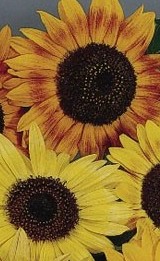 The large genus of Helianthus includes bth annualas and perennials but the most commonly grown is an annual, Helianthus annus. The plants are usually tall and bear very large showy flowerheads of yellow, orange or cream ray flowers surrounding a center of dark disc flowers that produce the seeds. A single flowerhead may produce a couple of thousand seeds, all tightly packed in the center. Sunflowers are cross-pollinated by insects so only one variety should be grown at a time if pure strains are wanted for seed collection. Alternatively, different varieties can be planted 1000 feet apart. Even with these precautions insects may cross your sunflowers with wild sunflowers. Hybrids and cultivars will not breed true.
The large genus of Helianthus includes bth annualas and perennials but the most commonly grown is an annual, Helianthus annus. The plants are usually tall and bear very large showy flowerheads of yellow, orange or cream ray flowers surrounding a center of dark disc flowers that produce the seeds. A single flowerhead may produce a couple of thousand seeds, all tightly packed in the center. Sunflowers are cross-pollinated by insects so only one variety should be grown at a time if pure strains are wanted for seed collection. Alternatively, different varieties can be planted 1000 feet apart. Even with these precautions insects may cross your sunflowers with wild sunflowers. Hybrids and cultivars will not breed true.
Sunflowers bloom from summer into fall and seed collection procedures begin early in the season. Seed harvesting is most successful in dry sunny weather as mold may grow under wet or humid conditions.
Directions for Seed Collection:
1. As soon as the seeds are formed but are immature, cover with netting or cheesecloth so the seeds can ripen unharmed by birds and other wildlife. Avoid plastic bags as they can facilitate the development of mold or heat build up. Avoid paperbags as they get wet and collapse when it rains.
2. When the petals (actually ray flowers) have shriveled and the back of the flowerhead is yellow cut the flower heads leaving a 12 inch long stem on the flowerhead.
3. Hang up the flowerheads by the stem in a dry well ventilated place free from rodents for several weeks.
4. Collect the seeds when they are ripe; the back of the flowerhead will be brown and the seeds will drop easily from the flowerhead when you rub them with you hand.
5. Dry the seeds on paper for another week or two in a dry, rodent-free place.
6. Choose only the plumpest seeds for planting as they are the ones that are most likely to germinate and produce large strong plants.
7. Store seeds in a paper bag sealed in a glass jar and label with strain and date.
8. Placed in a dry cool area and plan to use the next spring as sunflower seeds are not viable for more than a year.